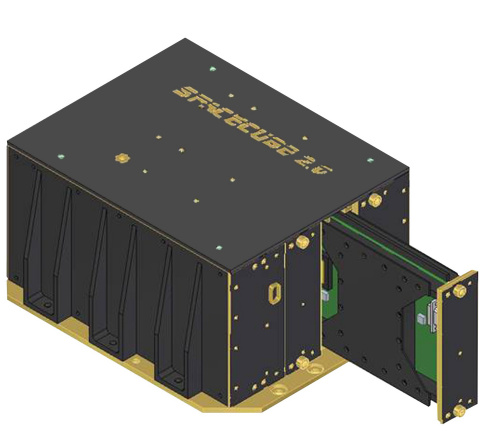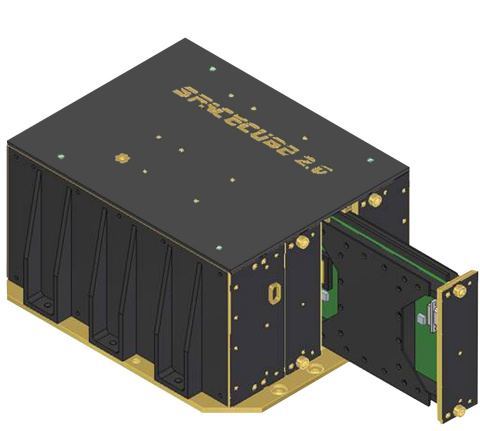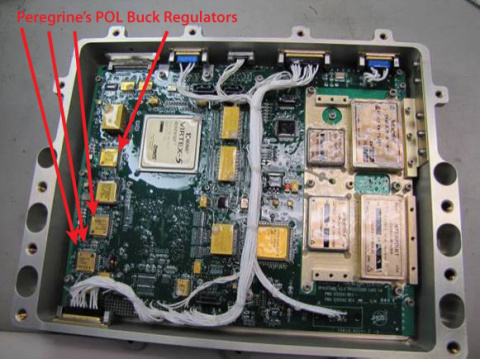SAN DIEGO--(BUSINESS WIRE)--Peregrine Semiconductor Corporation (NASDAQ: PSMI), a fabless provider of high-performance radio frequency integrated circuits (RFICs), is receiving early reports from NASA’s Goddard Space Flight Center that its UltraCMOS®-based power management solution is delivering uninterrupted high performance while meeting the radiation-hardened and extreme-temperature requirements at the International Space Station. Selected for NASA’s SpaceCube 2.0 Hybrid Science Data Processor, Peregrine’s Point-of-Load (POL) DC-DC Buck Regulators with integrated switches helped the design team meet its goals of delivering “order-of-magnitude improvements” in on-orbit computing performance over traditional flight computing systems.
The Goddard Space Flight Center’s SpaceCube systems are “next generation,” on-board science-data processors for space missions. The SpaceCube provides 10-100 times the standard on-board computing power while lowering relative power consumption and cost. The DoD Space Test Program-Houston 4-ISS SpaceCube Experiment 2.0 (STP-H4-ISE 2.0) marks the maiden voyage of the SpaceCube 2.0 model, which achieved a design goal of reducing the PCB card size of the previous model from 8” by 6” to 7” by 4” and increasing processing speed. The extra performance and smaller size enable SpaceCube 2.0 to support four HD cameras and the “FireStation” heliophysics instrumentation package, which detects and measures terrestrial gamma-ray flashes from lightning and thunderstorms.
“We’re building cutting-edge space computing systems at NASA’s Goddard Space Flight Center, so every component within our design must represent the smallest, most efficient, most innovative technology in its class while also meeting harsh radiation- and temperature-durability standards with unfailing reliability,” said Dave Petrick, embedded systems group leader at NASA Goddard’s Science Data Processing Branch. “Capable of providing up to 10A of clean power, Peregrine’s space-grade POL power management system was the perfect fit for our system’s needs – literally – offering unmatched 85-90 percent power efficiency, configurable load sequencing, as well as a very flexible, monolithic design within the smallest package we found on the market.”
The SpaceCube 2.0 design uses four of Peregrine’s PE99155 point of load (POL) power management chips to provide regulated power at multiple supply voltages for the processing elements, memory and associated circuitry like oscillators and gigabit transceivers. Peregrine’s flexible and small-form-factor design allowed all of the regulation functions to be placed on a single PCB, realizing area and overall power-consumption savings over the SpaceCube 1.0 power design, which previously required multiple PCBs using conventional linear-regulator bricks. Peregrine’s design-configuration tool helped NASA to improve power efficiency by 15 percent, allowing a simplified thermal design and wider operating-temperature range for the system in orbit. In addition, Peregrine’s UltraCMOS technology is immune to latch-up due to cosmic ray strikes (known as single-event latch-ups, or SELs) that are common even in low-earth orbits.
“Peregrine has been supplying components to NASA for more than 12 years,” said Dave Shepard, vice president of Peregrine’s high-performance solutions business unit. “We are proud to be handling power regulation for NASA’s SpaceCube 2.0 and applaud NASA for its innovative design and the early success reported this week.”
About Peregrine Semiconductor
Peregrine Semiconductor (NASDAQ: PSMI) is a fabless provider of high-performance radio frequency integrated circuits (RFICs). Our solutions leverage our proprietary UltraCMOS® technology, an advanced RF Silicon-On-Insulator process. Our products deliver what we believe is an industry-leading combination of performance and monolithic integration, and target a broad range of applications in the aerospace and defense, broadband, industrial, mobile wireless device, test and measurement equipment, and wireless infrastructure markets. Additional information is available at http://www.psemi.com.
The Peregrine Semiconductor name, logo, and UltraCMOS are registered trademarks of Peregrine Semiconductor Corporation in the U.S.A., and other countries. All other trademarks mentioned herein are the property of their respective owners.






